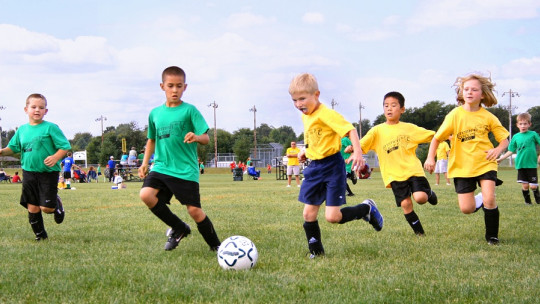
Make children and adolescents become independent and autonomous people It is one of the main objectives that fathers and mothers have set for themselves at some point in their lives.
And the truth is that although this process of educating young people to be more free sounds very good, it is not a bed of roses, and many times it presents great difficulties: rebellious teenagers who prefer not to make an effort, fathers and mothers who unconsciously sabotage their children’s attempts to do things autonomously, lack of guidelines to follow, etc.
Below I will show keys to understanding what the learning and education process should be like to form more independent children and young people
Keys to educating in autonomy focused on parents
Part of the changes to be made to promote the independence of children must be made in the way of thinking and in the behavior of the adults who care for them. These are the guidelines that must be taken into account.
1. Believe in your ability
The first step when facilitating the autonomous learning process of children and adolescents is believe that they are capable of carrying it out Something that seems very simple when written but, in reality, is not so simple; It means seeing with different eyes both the behavior of your children and your own role as a father, mother or legal guardian.
A young person will not begin to act autonomously if the implicit message communicated by someone who encourages them to do so is that this is a task that someone else must do for them, giving them orders or deciding what should be done.
2. Lose your fear of the situation
Many parents unconsciously stop their children’s autonomous learning because They are afraid of what may happen Since the existence of an independent daughter or son means that one loses control over what this person does, pessimistic ideas about what may happen can frequently assault our imagination. For example, you think about the dangerous friendships you may make, the drug use you may be exposed to, the accidents you may suffer for not being careful, etc.
These ideas have such a strong emotional impact that, when parents see their sons or daughters beginning to gain independence, Their attention is focused on these catastrophic thoughts, as if their existence were in itself a real danger From there we move on to rumination, that is, thinking in a loop about what produces stress: in this case, the (relative) dangers of having sons or daughters who are more independent than before. Adults feel bad because they imagine those situations, and they imagine those situations because they feel bad.
To solve this, it is necessary to go through two phases:
Restructuring of ideas
It must be clear that the dangers that autonomous people face due to not having the constant surveillance of a protective figure are very relative, and that the real possibilities of these omens coming true are very low. On the other hand, we must remember that the much more likely danger is to raise a daughter or son who remains helpless even when they have long entered adulthood, if their attitude is not changed.
Break rumination
Managing the initial stress that in some cases may mean giving children and adolescents more autonomy becomes necessary in some cases. To do this, you can read this article about what rumination is and how it can be neutralized.
3. Admit the need to try harder
Educating independent sons and daughters is one more task within the series of activities involved in the education of new generations and, therefore, requires extra effort Although it may seem that constantly controlling children and adolescents is a major hassle, in reality it is not: helping children to become empowered means teaching them the tools to do so, and that is something that is difficult, especially at the beginning.
On the other hand, impatience and the desire not to dedicate much time to an activity that is being learned means that many parents prevent the possibility of learning fundamental tasks such as dressing or bathing, in younger children, or going out shopping and maintain some savings, in adolescents. That is why we must keep in mind that the first times are always slow and difficult, and that “accelerating” those moments by intervening oneself in what the young person should be doing is a way of sabotaging learning, no matter how convenient it may be. for one’s own comfort.
For this reason, parents and caregivers must keep in mind that many times their children’s lack of initiative and autonomy arises from the fact that they themselves prefer to continue exercising control, because that is more comfortable and simple, and that This attitude causes attempts to behave independently to be rejected and punished
4. Know how to detect requests for independence
In their position as people who really know what is happening better than the girls and boys they educate, Parents and guardians often underestimate their own judgment and the requests of their children, believing that they know how to interpret what they really want better than them. This reasoning is fallacious and, furthermore, it is a way of creating a series of ideas about one’s relationship with one’s children that will never be challenged or forced to adapt to the pace of their growth.
When a child says “I’m alone” when performing a task they are learning, it is necessary for the caregiver to spend at least a few seconds thinking about whether opposing this request is really reasonable or not. Likewise, we must keep in mind that the requests for autonomy from the little ones are very diverse and, in some cases, subtle, and that it is necessary to develop a certain sensitivity to know how to detect them.

Strategies to educate in independence focused on young people
Now that we have seen what attitude adults should adopt when educating young people and children to be independent, Let’s see how change can be promoted in these last
1. Spend more time together
Something as simple as spending more time with young people is an ingredient that promotes learning exponentially. Of course, They must be times in which the time shared is of quality: being in the same room watching two different screens with an account, because there is no dialogue.
The conversations and games that appear spontaneously in these contexts are a source of knowledge that make young people see the world with different eyes, ask themselves new questions and become interested in more topics. The latter is essential, since curiosity is the driving force of learning.
2. Investigate your tastes and interests
The most effective way to get children and young people interested in learning new activities that give them more autonomy is to relate them to the topics that interest them either creating narratives in which the topics of interest and those that must be learned are framed, or exercises in which both elements are found.
3. Experiment with reward systems
In some cases, Incentive systems similar to the token economy can be useful to boost learning and independence: Whenever significant enough progress is made, a reward is given that should not be delayed.
Ideally, the rewards should be scarce and more symbolic than material, since in this way they symbolize the obtaining of a series of skills and abilities that are a consequence of learning itself, instead of being something totally unrelated to this and, Therefore, they are more related to intrinsic motivation.
This strategy, added to the previous one, can make incentives more attractive. For example, if the boy or girl has a lot of interest in fictions based on a magical world, the rewards can be medals related to those fictional universes.








